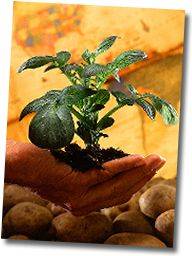|



| |
Jack Kerrigan
Many changes occur as a person ages. These changes impact a
person's physical, emotional and cognitive abilities as well as social roles.
Gardening can be used in a therapeutic way to address these issues and improve
the elderly person's physical and emotional conditions, cognitive ability and
social interactions. However, many of the changes involved in aging must be
addressed by modifications in gardening practices, situations and tools. Changes
that occur with age are listed in the following chart as well as the impacts of
the changes and the gardening adaptations that can result in continued
participation.
|
Life changes caused by aging |
Impacts |
Gardening Adaptations |
|
Physical |
|
Vision: The lens thickens, yellows and becomes opaque.
|
Reduced clarity. Blue, violet and green harder to see.
Depth perception is diminished. |
Paint tools a bright color. Use larger seed or pelletized
seed. Grow plants with more tactile and olfactory stimulation. Use vertical
planting. Create smooth surfaced paths. |
|
Muscular and skeletal: There is reduced agility, balance
and strength and an increase in tremors and broken bones. |
Difficulty lifting and moving objects. Falling is more
likely. Gardening becomes more difficult. |
Raised beds reduce the need to bend or kneel. The edges
of raised beds can provide a place to sit while gardening. Stools provide an
intermediate step between standard gardening and raised beds. Adaptive tools
with better leverage and improved grips help make gardening easier.
|
|
Temperature adaptability: The body does not adjust as
quickly or as well to temperature extremes and changes. |
High and low temperatures are not tolerated as well.
Hyperthermia or heatstroke is more likely. Heat exhaustion caused by loss of
body water and salt is likely. Sunburn, eczema, dermatitis and infections
increase. |
Garden early in the morning or late in the day. Drink
water and juice and avoid alcoholic beverages. Shower frequently or splash
water on the body. Wear lightweight, loose fitting clothes that cover
exposed skin. Wear a hat. Apply sunscreen. Eat light meals. Discuss heat
related problems that may be complicated by medications with a physician.
Wear gloves. Soak cuts and punctures in a mild salt solution (1 teaspoon per
cup of water) until scab forms. |
|
Disease and chronic conditions: arthritis and rheumatism,
heart disease, kidney function |
Strength decreases and pain increases. The person tires
easily. Urination increases in frequency. |
Adaptive tools combined with light, easily worked soil
allow gardening activities to continue. Indoor and container gardening
projects are more appropriate. Frequent resting periods and a cool place to
rest are needed. Bathroom facilities should be near the garden. |
|
Cognitive |
|
Concept development may decrease if the person is not
active and social. Alzheimer's disease is more likely, resulting in loss of
short-term memory. |
It becomes more difficult to learn new skills and to
remember recent activities. |
The garden can be kept simple with less confusing
plantings. Plants that trigger memories can be planted. A distinctive and
familiar focal point allows for easier orientation and wayfinding.
|
|
Reaction time increases. |
The learning pace slows. Accidents with power tools are
more likely. |
Avoid the use of power tools. Allow plenty of time for
gardening activities, keeping the pace leisurely. |
|
Societal Roles |
|
Sense of security and safety is decreased. |
This increases the level of fear of outside events and
accidents. |
Gardening activities should be in a safe place that
provides a sense of security. Fences and walls provide security. Gardening
with other people provides security and safety. |
|
Family roles change. Economically the elderly person
becomes more dependent and loses control of many aspects of life. Family and
friends may move or die, isolating the person. Self-esteem and
self-confidence are reduced. |
This can result in aggressive behavior, isolation,
regression or depression. |
Gardening activities should be kept low in cost. The
gardener should be given control over his or her area of the garden or have
his or her own plants to care for. The gardener should be allowed to express
individuality while working within a group. In groups, a committee structure
can be used to make policies and solve problems. Social activities
associated with the garden should be encouraged. Allow gardeners to teach
others. Inter-generational activities are particularly effective.
|
Resources
Sources of adaptive tools adaptability, Post Office Box 515,
Colchester, CT 06415
Lehman Hardware and Appliances, 4779 Kidron Road, Post Office
Box 41, Kidron, OH 44636
Mellingers, Inc., 2310 West South Range, North Lima, OH 44452
Park Seed Co., Cokesbury Road, Greenwood, SC 29647
Walt Nicke Co., 36 McLeod Lane, Post Office Box 433, Topfield,
MA 01983
W. Atlee Burpee & Co., 300 Park Avenue, Warminster, PA 18974
Sources of information from organizations and agencies
American Horticultural Therapy Association, Wightman Road,
Suite 300, Gaithersburg, MD 20879
American Association of Retired Persons, National
Headquarters, 1909 K Street NW, Washington, DC 20049 Council on Aging, 600
Maryland Avenue SW, Washington, DC 20024
|
![]() Gardeners' Corner
Kids'
Garden
Sustainable Garden
Contact Us
Gardeners' Corner
Kids'
Garden
Sustainable Garden
Contact Us![]()

